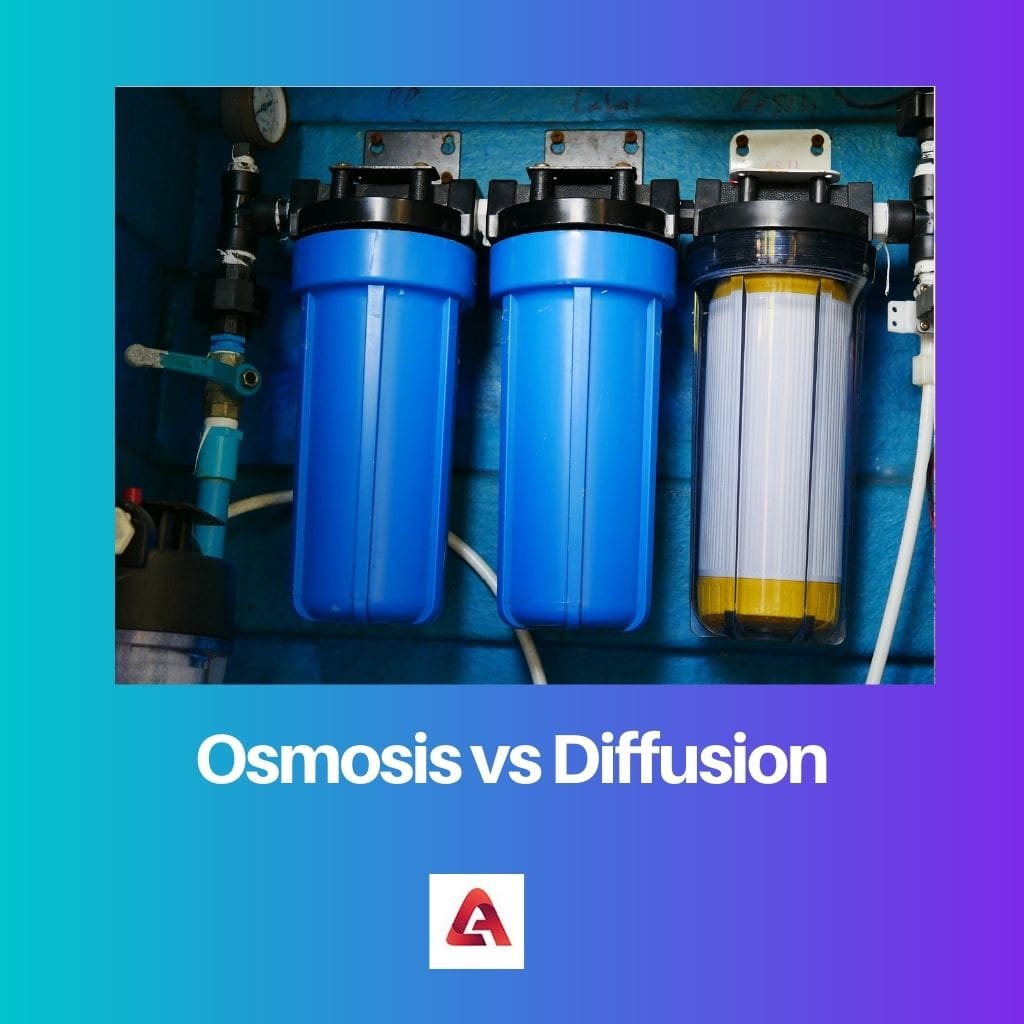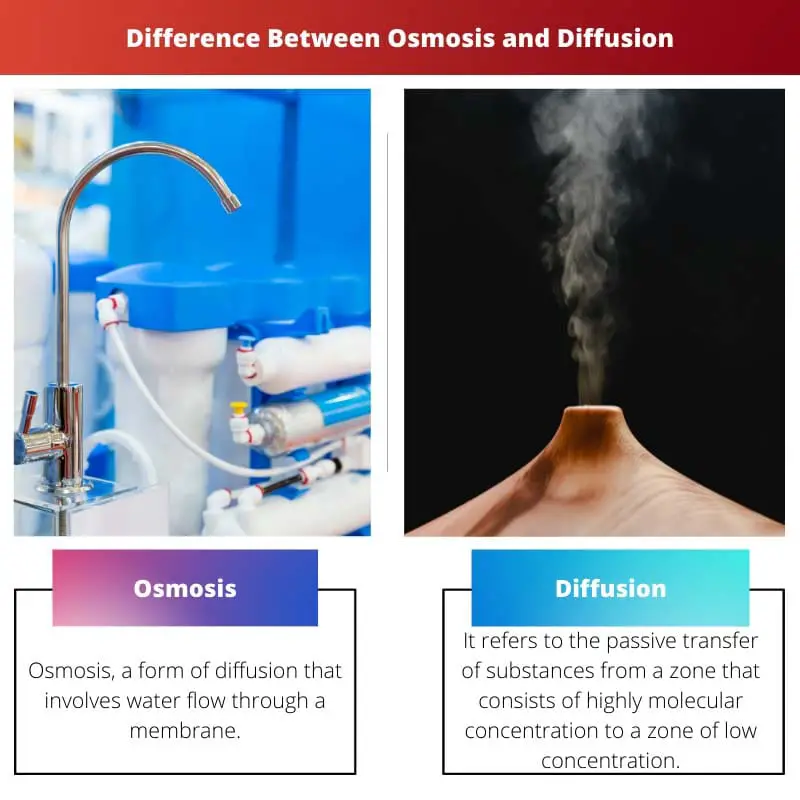Osmosis and diffusion are the two distinct forms of passive transport that play an essential role in transporting molecules through and out of the cell. Students are mostly asked to clarify the similarities and disparities between osmosis and diffusion or to compare the two modes of transport and contrast them.
It would be best if you learned the meanings of osmosis and diffusion to address the issue and fully appreciate what they mean.
Key Takeaways
- Osmosis is the passive movement of water molecules across a selectively permeable membrane from an area of low solute concentration to an area of high solute concentration until equilibrium is reached.
- Diffusion is the passive movement of particles, such as molecules or ions, from an area of high concentration to an area of low concentration until equilibrium is reached, not limited to water molecules.
- Both osmosis and diffusion are passive transport processes that rely on the natural movement of particles to achieve balance, but osmosis specifically involves water molecules and a selectively permeable membrane.
Osmosis vs Diffusion
The difference between Osmosis and Diffusion is their dependency and requirements. Osmosis relies on the number of dissolved solute shreds in the solution. Nonetheless, the diffusion relies upon the existence of additional components. The former needs water for the activity of particles. Whereas the latter move without the requirement of water.

Comparison Table
| Parameter of Comparison | Diffusion | Osmosis |
|---|---|---|
| Semi-permeable membrane | The availability of a partly-permeable membrane is essential | For this process to occur, the availability of a partly-permeable membrane is essential |
| Hydrostatic and Turgor pressure | Typically hydrostatic pressure and turgor pressure are not crucial in diffusion. | Osmosis is opposed by hydrostatic pressure and turgor pressure. |
| Pressure, water, and solute potentials | Pressure potential, water potential, and solute potential do not affect diffusion. | The solute potential is necessary for osmosis to take place. |
| Reliability on other molecules | Diffusion relies mainly upon the existence of other molecules. | Osmosis relies primarily on the number of dissolved solute particles in the solvent. |
| Medium | This is a versatile process, and it can take place in any medium, whether it is a liquid, gaseous or solid medium. | A liquid medium is necessary for this process to take place. |
What is Osmosis?
Osmosis is a form of diffusion that involves water flow through a membrane that is partially permeable from a zone with a high concentration of water to a low concentration zone.
Osmosis is a process that occurs in all cells. For example, in the case of red blood cells, when put in water, they must let the water flow through their membrane.
The red blood cell shrinks when put in a concentrated solution of sugar, as the water travels through osmosis into the region with lower concentration. For this reason, when seen through a microscope, the cells look shrank.
Luckily, this rarely occurs inside the bloodstream, as the kidneys ensure that the blood content is the same as the water content within the red blood cell.
Like the red blood cells, the cells in plants on the exterior of the cell membrane have a somewhat thicker and more stable cell structure. It helps the plant cells consume much water without bursting through osmosis.
Plants would not be able to remove water from the soil without osmosis. When osmosis allows plant cells to expel so much water, they become less compact and gradually the membrane shrinks.

What is Diffusion?
This process refers to the passive transfer of substances from a zone that consists of high molecular concentration to a zone of low concentration. When it occurs between cells is the mode of transfer of small substances via the cell membrane.
Molecules are always continuously moving. Temperature, a popular measure for people in their everyday lives, is closely linked to this motion.
This is a measurement of the molecules ‘average kinetic energy (average) in a substance.
The molecular energy induces spontaneous motion that, in effect, stimulates diffusion. Collisions between molecules are common.
Diffusion verifies air quality by redistributing chemical compounds, such as atmospheric oxygen, until equilibrium is reached. The factors affecting this process are temperature, distance particles must travel and concentration gradient.
Here are some instances of diffusion. Spraying a scent in a space will make things feel good for a moment, but the odour molecules will be dispersed over time before their frequency becomes imperceptible to the human nose.
Another excellent illustration of diffusion is dipping a colour in a container of water, which can alter the appearance of the entire solution (water).
As there are various conditions for diffusion, scientists have identified several forms of this process.
- Simple diffusion: This is where materials are transferred without protein assistance.
- Facilitated diffusion: Needs transport proteins to move materials via the membrane of a cell.
- Dialysis is the diffusion of solutes through a partially permeable membrane.
- Osmosis: This is referred to as water diffusion, which is characterized as a solvent of choice over a selectively permeable membrane in all living systems.

Main Differences Between Osmosis and Diffusion
- Osmosis involves solvent movements from lower to higher concentration regions, while diffusion is characterized by solvent movement from higher to lower concentration regions.
- Diffusion can be observed in any combination of a mixture, even a partially-permeable membrane, whereas osmosis is only observed across a partially permeable membrane.
- Solvent and solute materials can travel during diffusion, while only the solvent materials are allowed to pass through the membrane in osmosis; in this situation, they are water molecules.
- During osmosis, particle movement happens only in one direction, while the movement of particles happens in all directions during diffusion.
- Once the osmosis process is in effect, extra pressure on the solution side may either halt or reverse the process, while the diffusion process can neither be halted nor reversed.

- https://trid.trb.org/view/354006
- https://www.lifescied.org/doi/pdf/10.1187/cbe.11-04-0038
- https://www.ncbi.nlm.nih.gov/pmc/articles/PMC541081/

This article is a bit too technical for my liking, but I appreciate the detailed information.
I understand what you mean, Kennedy. The technical terms can be overwhelming, but the article is very informative.
I found the explanations regarding osmosis and diffusion quite fascinating and easy to understand.
Absolutely, Jessica! This article makes complex topics accessible to everyone.
Thanks for the in-depth explanation of osmosis and diffusion. It’s quite helpful!
I agree, Kelly! This article provides a great comparison of the two processes.
The comparison table is very useful in highlighting the differences between osmosis and diffusion.
I found the table quite helpful too, Lizzie. It simplifies the comparison for better understanding.
Absolutely, Lizzie. The table is a great addition to this informative article.
The real-life examples used to explain osmosis and diffusion are engaging and enrich the overall content.
I totally agree, Frank. The real-life examples add a fascinating dimension to the article.
I think the article could be more stimulating, but the information provided is top-notch!
You’re right, Saunders. Perhaps some added interactivity would enhance the article.
I think the article could have been more engaging, but the content itself is enriching.
I agree, Uevans. The content is great, but it could use some more engaging elements.
I appreciate the detailed breakdown of osmosis and diffusion. It’s certainly educational!
I agree, Lee. The educational value of this article is truly commendable.
I used to confuse osmosis and diffusion, but now it’s crystal clear. Great article!
I know the feeling, Miller. This really cleared things up for me too.
This article is quite informative. I now have a better understanding of osmosis and diffusion.
I think the extensive explanation of osmosis and diffusion makes it easier for students to comprehend the concepts.
Definitely, Thomas! This article is a valuable resource for students studying biology.